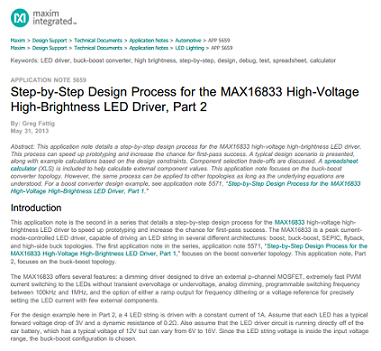
This application note is the second in a series that details a step-by-step design process for the MAX16833 high-voltage high-brightness LED driver to speed up prototyping and increase the chance for first-pass success. The MAX16833 is a peak current-mode-controlled LED driver, capable of driving an LED string in several different architectures: boost, buck-boost, SEPIC, flyback, and high-side buck topologies. The first application note in the series, application note 5571, “Step-by-Step Design Process for the MAX16833 High-Voltage High-Brightness LED Driver, Part 1,” focuses on the boost converter topology. This application note, Part 2, focuses on the buck-boost topology.
The MAX16833 offers several features: a dimming driver designed to drive an external p-channel MOSFET, extremely fast PWM current switching to the LEDs without transient overvoltage or undervoltage, analog dimming, programmable switching frequency between 100kHz and 1MHz, and the option of either a ramp output for frequency dithering or a voltage reference for precisely setting the LED current with few external components.
For the design example here in Part 2, a 4 LED string is driven with a constant current of 1A. Assume that each LED has a typical forward voltage drop of 3V and a dynamic resistance of 0.2Ω. Also assume that the LED driver circuit is running directly off of the car battery, which has a typical voltage of 12V but can vary from 6V to 16V. Since the LED string voltage is inside the input voltage range, the buck-boost configuration is chosen.
Advertisement

Learn more about Maxim Integrated





